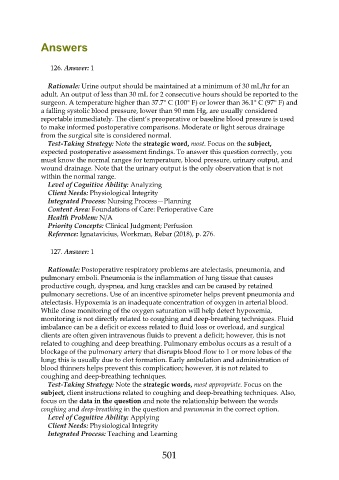Page 501 - Saunders Comprehensive Review For NCLEX-RN
P. 501
Answers
126. Answer: 1
Rationale: Urine output should be maintained at a minimum of 30 mL/hr for an
adult. An output of less than 30 mL for 2 consecutive hours should be reported to the
surgeon. A temperature higher than 37.7° C (100° F) or lower than 36.1° C (97° F) and
a falling systolic blood pressure, lower than 90 mm Hg, are usually considered
reportable immediately. The client’s preoperative or baseline blood pressure is used
to make informed postoperative comparisons. Moderate or light serous drainage
from the surgical site is considered normal.
Test-Taking Strategy: Note the strategic word, most. Focus on the subject,
expected postoperative assessment findings. To answer this question correctly, you
must know the normal ranges for temperature, blood pressure, urinary output, and
wound drainage. Note that the urinary output is the only observation that is not
within the normal range.
Level of Cognitive Ability: Analyzing
Client Needs: Physiological Integrity
Integrated Process: Nursing Process—Planning
Content Area: Foundations of Care: Perioperative Care
Health Problem: N/A
Priority Concepts: Clinical Judgment; Perfusion
Reference: Ignatavicius, Workman, Rebar (2018), p. 276.
127. Answer: 1
Rationale: Postoperative respiratory problems are atelectasis, pneumonia, and
pulmonary emboli. Pneumonia is the inflammation of lung tissue that causes
productive cough, dyspnea, and lung crackles and can be caused by retained
pulmonary secretions. Use of an incentive spirometer helps prevent pneumonia and
atelectasis. Hypoxemia is an inadequate concentration of oxygen in arterial blood.
While close monitoring of the oxygen saturation will help detect hypoxemia,
monitoring is not directly related to coughing and deep-breathing techniques. Fluid
imbalance can be a deficit or excess related to fluid loss or overload, and surgical
clients are often given intravenous fluids to prevent a deficit; however, this is not
related to coughing and deep breathing. Pulmonary embolus occurs as a result of a
blockage of the pulmonary artery that disrupts blood flow to 1 or more lobes of the
lung; this is usually due to clot formation. Early ambulation and administration of
blood thinners helps prevent this complication; however, it is not related to
coughing and deep-breathing techniques.
Test-Taking Strategy: Note the strategic words, most appropriate. Focus on the
subject, client instructions related to coughing and deep-breathing techniques. Also,
focus on the data in the question and note the relationship between the words
coughing and deep-breathing in the question and pneumonia in the correct option.
Level of Cognitive Ability: Applying
Client Needs: Physiological Integrity
Integrated Process: Teaching and Learning
501

